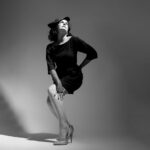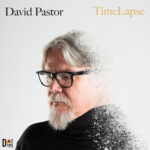
Rachel Z’s Album Sensual feat. Omar Hakim is OUT NOW!
Rachel Z is a renowned, virtuoso pianist, keyboardist, composer, and electronic musician with a star-studded resume, as well as 13 records as a leader. As
Peek Into The Private Library of Lennie Tristano
Dot Time Records and Mosaic Records, in partnership for the first time, are thrilled to announce the release of Lennie Tristano Personal Recordings 1946 – 1970. This 6-CD set chronicles over twenty years of stunning creative output from jazz luminary Lennie Tristano offering listeners the most comprehensive portrait of Tristano’s musical genius available.
The Limited Edition Box set includes:
Deeply Moving, Deeply Personal, and Completely Unknown – Until Now. One of the greatest pleasures we experience at Mosaic is uncovering rare, overlooked gems by acknowledged masters from whom we’ve all believed we’ve heard the last word. Often in scouring the archives for cleaner, better source material we uncover a few unknown recordings, forgotten sessions, or viable alternate takes that are no less fascinating than the selections initially approved for release.
We take great pride in adding to the known canon of work by giants, even when only a few recordings come to light.
So imagine how we feel about our new set, “Lennie Tristano Personal Recordings 1946-1970.” Jerry Roche, the Director of A&R at Dot Time Records supervised the release of these treasures, selected by Lennie Tristano’s daughter Carol and sonically restored by tenor saxophonist Lenny Popkin, a Tristano disciple and sideman.
The recordings come from a trove of material in Tristano’s personal collection — air-checks, remote wire recordings, live dates preserved by his associates on the bandstand, and tracks laid down at Lennie’s East 32nd Street studio in New York. Not originally intended for commercial release, they provide an intimate look at Tristano’s range and his unmistakable approach to jazz.
Uncategorizable Brilliance Tristano is often mis-categorized as a disciple of the “cool” style of jazz, possibly because his approach was so measured, lyrical, and precise in contrast to the jagged energy of bebop. But the breath and depth of his playing stretch far beyond that post World War II genre in both directions.
A student from the American Conservatory of Music in Chicago, he started making a name for himself in New York in the mid-1940s, even playing alongside Charlie Parker, Dizzy Gillespie, and Max Roach. The beboppers marveled at his exceptional harmonic gifts, his ability at playing long, intricate solo lines, and his unerring virtuosity. He contributed to the music of Parker and Gillespie without slavishly copying their approach.
Tristano was critical of the bebop movement, but his comments could apply to anyone who was a follower and not a leader. “Whether they play drums, saxophone, piano, trombone, or glockenspiel, it still comes out Gillespie,” he wrote.
His belief that music must express something personal led to his decision to start his own school, stressing that playing jazz needs to entail more than learning chord changes and picking an idol to copy. Tristano began focusing on jazz education from a personal studio he established while he was still performing regularly.
That studio (where some of the tracks on this set were recorded) was to be a hub for Tristano for many endeavors – a first-of-its-kind school of jazz for players at all levels, the domain for his recording and publishing companies, a recording studio, and a performance spot. While some of his ambitions went unrealized, his devotion to teaching – as he himself said, the “method and madness” of jazz – pointed to his strong belief that harmony, ear training, composition, and technique were all critical components of a fully formed musician.
As for what genre his belongs to, keep in mind that Tristano was always looking ahead. He is believed to have recorded the first-ever ensemble free jazz compositions, abandoning chord structure and song forms to follow wherever a motif or phrase could lead, stressing listening over playing. He also experimented with overdubbing at a time when that idea was so new that most reviewers had no idea what they were hearing.
While to some ears Tristano sounds remote or mechanical in his long runs of even eighth notes, a more careful listening reveals the playfulness and passion in his approach on piano. There’s a lot of Art Tatum in his soloing, like someone with too many notes in him to fit them all in a bar of music. Despite the intricacy, it never overshadows his ease. His block chords were a major influence on Bill Evans. His drive and power, and his fascination with exploding traditional song formats, inspired Cecil Taylor.
More in one set than was released during his lifetime
This set follows an unusual pattern for a Mosaic release in that it is not presented in chronological order, but rather themed to a style of presentation crossing eras and personnel.
Disc 1 Features Tristano alongside Billy Bauer and Arnold Fishkin. These live trio recordings from 1946/1947 were recorded in Long Island, New York and capture the pure synergy, improvisational acuity and playfulness of this tight-knit ensemble. Right away, one notes Tristano’s incredible feel. “As it is expressed by his playing both as a soloist and playing with others, every note he plays has a personality. Every note is imbued with feeling. In the recordings presented in this set, you will hear that no matter what the tempo, the key, whether he is playing quarter notes, eighth notes, sixteenth notes – no matter how fast, each note is distinct. Each note has character,” reflects Popkin.
Disc 2 Features marvelous solo piano recordings of Tristano recorded both at Rudy Van Gelder Studio and at Lennie’s own East 32nd Street studio. The 15 tracks on this disc demonstrate Tristano’s inner world of harmony.
Disc 3 Features live sextet recordings of Tristano alongside Lee Konitz, Warne Marsh, Billy Bauer, bassists Arnold Fishkin and Joe Shulman, and drummer Jeff Morton. This marks the first recorded performance of a group of jazz musicians performing free jazz in front of an audience in a club. Lennie Tristano’s daughter and co-producer of this album, Carol Tristano indicates that “he embodies that link between free playing and swinging jazz.
The free playing of these four musicians together has, to this day, almost no parallel. It is not random, nor is it instant composing. It is rooted in jazz feeling and being created completely spontaneously in the moment. The result is no experiment! Each piece tells a story and is great music of the highest order. You may find it can remind you of what it’s like to listen to a great composition — but it’s not composed — that’s the magic of it!”
Disc 4 Features Tristano playing straight-ahead jazz with two fantastic trios both with Peter Ind on bass, one with drummer Tom Wayburn, the other with drummer Al Levitt. “The trio sides with Peter Ind, Tom Weyburn and Al Levitt are among my favorites. Lennie with a rhythm section — wowing you with his lyrical prowess, doing that thing that great musicians can do — compelling your ear into a state of pure pleasure! No matter how many times you hear a great solo, it will affect you the same, if not more, every time,” shared Carol.
Disc 5 Contains duos and trios with bassist Sonny Dallas and drummer Nick Stabulas. The duo tracks capture the intentful listening of two friends and musicians eager to create beautiful music together, and the trio tracks demonstrate the rare interplay of three musicians who are connected to each other’s every melodic refrain and harmonic exploration. To quote Popkin,
Disc 6 Begins with a groundbreaking free jazz session from 1948 featuring Lee Konitz, Warne Marsh, Billy Bauer. The recording predates Tristano’s historic Capitol sides Intuition and Digression as well as iconic free jazz recordings of the late 50’s/early 60’s by other artists that so often receive the acclaim for Tristano’s early innovation.
As with all Mosaic sets, this release is extremely limited. When they are sold out, this music goes back into the vaults, never to be released in this form again. Please don’t miss out on this opportunity to fall under Tristano’s spell.

Rachel Z is a renowned, virtuoso pianist, keyboardist, composer, and electronic musician with a star-studded resume, as well as 13 records as a leader. As




